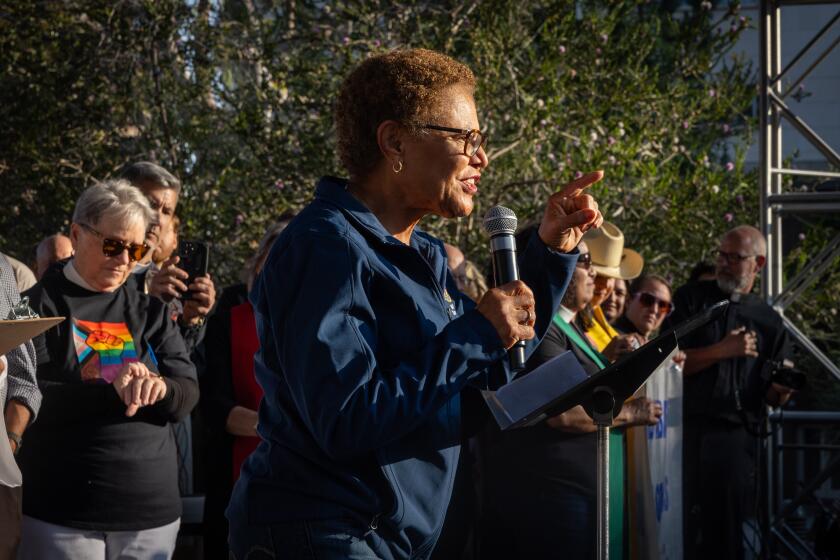Drug Busts to Help Fund New Inglewood Police
- Share via
Inglewood, a city that has fought crime with some success in past years, will have 20 additional police officers on the streets by summer.
And until revenue from a new tax assessment district becomes available at year’s end, drug dealers will help foot the bill for those new officers under a funding scheme worked out this week by city officials.
The additional officers will come aboard during a period when statistics show that the city has experienced a decrease in violent crimes and an increase in property crimes.
Although Inglewood voters overwhelmingly approved the property tax assessment to fund a $1.4-million, 20-officer task force against gangs and drugs last November, the assessment will not go into effect until the new fiscal year begins July 1, and revenue will not be collected until the end of the year.
The assessment will cost the owner of a single-family home about $45 a year. Apartment buildings will be assessed on a sliding scale beginning at $53 a unit. Commercial properties will be assessed on the basis of frontage.
The City Council on Tuesday approved the financing scheme for the immediate hiring of new patrol officers, who will replace veteran officers being assigned to the task force. The city will soon borrow about $649,000 from its water fund to pay for salaries, hiring and equipment.
That loan will be repaid with funds the city is owed by the federal government for property and assets seized by Inglewood police during drug busts, officials said. More than $683,000 is expected this year in such reimbursements, thanks to a new federal law that allows money and assets seized from drug dealers to be turned over to police departments for anti-drug operations.
“This is a great idea, making the drug dealers pay for it,” said Councilman Anthony Scardenzan, a longtime proponent of more police officers. “I love it.”
The 20 new officers will increase the 187-officer department by more than 10%.
The new police will include trained officers transferring from other departments and local residents being sought in a recruitment drive in Inglewood, officials said. Ten will be hired in March, three each in April and May, and four in June.
Because some of the newly hired officers will have to be trained at police academies and in the field, the anti-drug task force of veteran officers will not probably not reach full strength until August, said Deputy Chief Robert Gavney.
The plainclothes “crime suppression” task force, as it has been named, will consist of 17 officers, two sergeants and a lieutenant and will fight street-level drug and gang activity throughout the city.
City and police officials are enthusiastic about the beefed-up police presence. Capt. James Butts said the unit will provide a vigorous new show of force in areas where gang members congregate and intimidate residents. The task force will work with the department’s gang intelligence unit in targeting gang members with undercover operations, he said.
“We’re going to do all it takes to fight the perception of crime levels as well as crime itself,” Butts said. “When we have all the officers hired and in place, there should be a greater perception of safety.”
Although gangs and drugs are still a problem, crime has declined since the beginning of the decade, when Inglewood earned a bad reputation.
“The key thing is that we have this downward trend through the decade,” said police crime analyst Michael Easley. “The overall trend is down.”
Statistics released by the Police Department this week show slight decreases in violent crimes against people--murder, rape, robbery and aggravated assault--in 1988. Burglary declined as well, but property crimes--grand larceny, auto theft, arson and petty larceny--increased.
Although total crimes rose from 7,753 in 1987 to 7,966 in 1988, violent crimes decreased by 3% last year to 1,833, the lowest number in the decade, police said.
At the worst of Inglewood’s high-crime era, in 1981, police reported 10,933 total crimes and 2,266 violent crimes. Murders peaked that year at 55, compared to a recent annual average of about 29.
Robbery declined last year from 973 to 965, aggravated assault from 797 to 746 and burglary from 1,908 to 1,722, police said.
Easley said an assertive police presence is more likely to affect those types of crimes than murder or rape, which are harder to prevent.
Murders in Inglewood decreased from 32 in 1987 to 30 last year; rapes decreased from 100 to 92.
Property crimes overall increased about 5% last year, from 5,851 to 6,133, police said. Grand larcenies rose from 821 to 881, auto thefts from 1,795 to 1,846, incidents of arson from 93 to 133 and petty larcenies from 1,234 to 1551.
Easley said the new task force should reduce violent and property crimes by cracking down on violent, drug-dealing street gangs. But he cautioned against expecting an automatic decrease in crime statistics, saying more police activity may lead to more crimes being reported.
More to Read
Sign up for Essential California
The most important California stories and recommendations in your inbox every morning.
You may occasionally receive promotional content from the Los Angeles Times.













